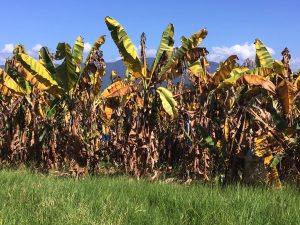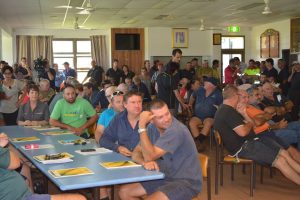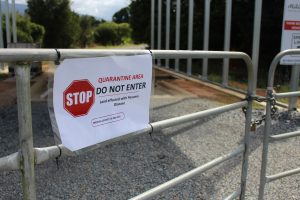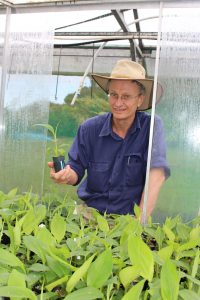
March marked five years since the first Queensland detection of Panama tropical race 4 (TR4) in the state’s far north. With four Tully farms now confirmed with the disease, we take a look back at some of the lessons learnt since March 2015; why the Australian banana industry has so far managed to contain this destructive disease more successfully than any other banana growing country in the world; and why it’s essential the fight continues.
Stewart Lindsay is candid when reflecting on the five years since Panama TR4 was first detected in the Tully Valley in 2015.
Casting his mind back to March of that year, the Department of Agriculture and Fisheries (DAF) banana authority said initially he would have predicted a much wider spread of the disease, than the four existing infested farms, by 2020.
“The fact that our industry is so mechanised, and that means there was a lot of contractors and their machinery moving between farms (before and atthe time of the first detection), I am stunned that we don’t have it spread more widely,” the DAF Team Leader – Banana Production Systems reflected.
“As time went on and we hadn’t seen any incursions on other farms it almost seemed like, “Could we have been that lucky? Could we have got it before it had spread anywhere else?” But it’s just not the way this disease works.
“If it had only been on the first infested farm, and it never went anywhere else, that would have been a miracle. And, that would have been as much luck as good management.”
Containment
Patrick Leahy – a long-time Tully banana grower who sits on the ‘varieties sub-committee’ of the Plant Protection Project Reference Committee – believes the industry’s swift response to contain the disease after the first detection in March 2015 played the most significant role in reducing further spread.
“The main thing that we’ve been able to do, that other countries haven’t, is the containment,” Mr Leahy said.
“As an industry, we went straight into quarantine- type mode, mostly at a farm level. We’ve kept vehicle movement in and out of our farms to a minimum.
“Growers that have done their on-farm biosecurity – that haven’t got TR4 – some have done it very well, some have done it at different levels, but the main thing is we’ve kept people and vehicles out of our farms.”
“The Philippines for instance, I’ve been there on a TR4 infected farm and the footbaths are virtually non-existent. They are just a mat with a bit of chemical on them, they’ve got mud on them, but the walkway through the farm, is to a village at the end. So, you’ve got a whole community that walks in and out of that farm every day.”
“In Taiwan, where they’ve had TR4 since the 1980s, on-farm biosecurity is nil.”

Grower Response
Australian Banana Growers’ Council (ABGC) Chair Stephen Lowe said he had little doubt the rapid response of growers to adopt the ‘come clean, leave clean’ mindset – right from the outset of the first detection – had played a major role in the containment of TR4 over the past five years.
“I applaud growers for the steps they have taken to improve their on-farm biosecurity, from those that have implemented world-class procedures to those that have done as much as they can,” Mr Lowe said.
“Collectively these actions have helped growers to not only protect their own businesses, but industry at large.”
Government and industry response setting biosecurity standards
Making sure that growers knew what to do to protect their farms was a priority for government and the industry from the start.
Biosecurity Queensland’s (BQ) Panama TR4 Program Leader Rhiannon Evans said “together we had to ask the ‘big questions’,” including – “What’s the most important thing we need to do right now? How do we contain it to the first property and how do we make sure growers know how to protect their farms?”
“One way was an agreed set of biosecurity standards and guidelines, focused on containing the disease, that BQ, ABGC and DAF used across all extension activities and into the BQ Panama TR4 Grower Kit.
“The banana industry employs many people in this region so BQ also wanted to make sure that
the community in general knew how to protect the industry from TR4. BQ travelled around the region promoting the biosecurity standards of ‘come clean/ leave clean’ and ‘never enter a banana farm without permission’ messages.
“We also work with organisations like Ergon, Telstra, local councils and emergency service providers to make sure they were doing what they can to not spread the disease.”
Farm buyout
The early industry buyout of the first infested property – partly funded by the Federal Government – is seen as another critical component of the Tully TR4 containment.
In August 2016, ABGC conducted a national ballot of all banana growers, which resulted in growers voting in favour of increasing the Plant Health Australia (PHA) levy to purchase the property.
The $4.5 million buyout was considered the best chance of protecting the remainder of the industry from further spread of the disease, allowing ABGC to immediately close all operations at the farm and destroy all banana plants on the 137 hectare-site.
Doug Phillips, who was Chair of ABGC at the time of the buyout, believes the purchase was key to the success of containment, for more reasons than one.
“Our focus from a very early stage was we have to contain this. We knew we couldn’t eradicate it,” Mr Phillips recounted.
“Being able to destroy all the bananas on that property was critical. We were able to isolate that farm, lock it down and eliminate movements on andoff that farm. But I also think it helped demonstrate to industry the significance of this disease and how important it was to get on top of it.”
Actions of infested farms
Mr Lowe said the actions of the operators of the three farms currently operating with TR4 also could not be understated.
He said the ability of these farm operators to meet their biosecurity obligations while continuing to trade with the disease, was a credit to their good management and preparation.
“All three farms operating with TR4 had good biosecurity protocols in place prior to getting this disease and this certainly helped them to not only return to production but ensure the greatest possible protection to the wider industry in containing further spread,” Mr Lowe said.
“They should be commended immensely for their efforts, particularly knowing how devastating it has been for all three farms to have to deal with such overwhelming circumstances.”

Early detection
As DAF’s Banana Production Systems’ Team Leader, Stewart Lindsay has travelled the world and witnessed the devastation that TR4 has had on other infested growing regions across the globe.
He said early detection is key.
“The fact that it (TR4) was found relatively early in Tully is really important. If you talk to the guys in the Philippines, the guys in Colombia and even in Mozambique, you get the same story, they (initially) thought it was Erwinia or Moko or one of the other diseases,” he said.
“In the Philippines, for five years they were managing TR4 like it was Moko, not realizing that it was different, and needed different management and biosecurity. But after five years has gone by, the disease has moved, and your ability to contain it is already lost.
Ms Evans said that early detection on the first infested property in Tully played a crucial role in containment.
“The first farm self-reporting meant government and industry could act quickly to contain this disease. If we get the disease early, the infected plant can be destroyed safely and biosecurity measures can be put in place to minimise spread.”
Surveillance
Finding TR4 early and destroying any infected plants safely is one of the best opportunities for containing the disease, therefore surveillance has been critical.
Ms Evans said, “following the first detection, we needed to know if TR4 was anywhere else, so BQ officers went to all banana farms across far northQueensland looking for TR4.
“Having surveillance officers walk up and down banana farms is one of the most effectice ways to detect the disease early, but it’s the costliest.
“These days BQ and industry agreed that the surveillance preogram is based on level of risk and we review the surveillance strategy review the surveillance strategy every couple of years to make sure we are addressing these risks.”
Ms Evans said to find the disease, growers were encouraged to check their own plants and were legally required to reports signs of the disease.
“We have had a few growers self-report and I know it is not an easy call to make. But if it is TR4 on your property, making this call can reduce the impact and give you the best chance of continuing to trade.”
Ground breaking collaboration
From the outset, industry and government has worked successfully together to provide the most rapid response to TR4 containment and ensure the delivery of the subsequent Panama TR4 Program.
While at times the partnership has had its challenges, it’s now progressed into a new Panama TR4 Program Management Board – comprising equal ABGC and DAF representation – which will see industry and government jointly fund the program until 2023.
The Board will give the banana industry the opportunity to participate in key decisions on the future management of TR4.
Sharing knowledge
Stewart Lindsay said while DAF had some useful knowledge and information for growers to improve their on-farm biosecurity levels, growers worked well to find solutions of their own and were happy to share their knowledge.
“In November 2015 we had the Panama TR4 field day at Wangan and the most popular segment was where we had five growers with videos ofeverything sharing and showcasing what they had done (to improve biosecurity on their farms) and they made themselves for available as a panel to answer questions,” Mr Lindsay said.
“Growers are fantastic at working out solutions to problems and have been very generous in their sharing. You’d see one grower that had done something really well, and then another grower did a different thing really well, they were happy to share that with the DAF/ABGC extension team. So we were then able to share that with the broader industry.”

Extension
After the detection of TR4 in Queensland it was important to get as much information as possible to growers about containing the disease, understanding it and how best to respond to it. For this to occur, it was important to establish a solid extension program.
ABGC immediately sought to obtain TR4 extension funding from both Governments to run comprehensive training for growers. At the time ABGC and DAF drew on the skills of former and existing staff, and also sourced new industry professionals to undertake the task.
“Part of that first strategy of ‘what do we have to do to stop this thing spreading’ (containment), was to get everybody in the industry (growers, suppliers etc) up to a common level of understanding about TR4,” Stewart Lindsay said.
“ABGC spoke to government and got funding support straight away to develop an extension program that would roll out in the form of biosecurity planning workshops supported by follow up farm visits.
“But in the early days, a couple of retired DAF people came back as ABGC employees for an amount of time to work to help pull this all together. So, we had existing DAF staff, ABGC staff, former DAF staff with skills and experience, and they all sat together and came up with what needed to be done. It was sort of a perfect secondment. But in a word, it’s co-operation.”
Mr Lindsay said this co-operative effort also involved growers, their market agents and supply chain, who also were heavily involved in the organisation and success of the extension workshops.
Research Preparedness
Jeff Daniells, Department of Agriculture and Fisheries (DAF) Principal Horticulturist, believes that Queensland’s leading banana research anddevelopment staff were well prepared for the state’s TR4 outbreak thanks to their involvement in research projects spanning over 20 years.
He highlighted in particular several international banana projects funded by the Australian Centre for International Agricultural Research (ACIAR)
– the earliest one going back to the late 80s. These projects allowed DAF staff to gain extensive experience off-shore with diseases such as blackSigatoka and Panama TR4 and elevated them onto the world stage.
Mr Daniells said these and other international opportunities allowed key banana R&D staff to travel extensively, visiting and learning from other banana research programs, as well as presenting their own learnings at global symposiums and workshops.
“Particularly since that first ACIAR project (in the late 80s), we (DAF) as an R&D effort in bananas, have been acknowledged highly since then, because it put us in the international arena and gave us a lot more opportunities to interact internationally.
“So when it comes to the crunch of the crisis (like TR4) you’ve got people that can be relatively cool in that crisis … and be able to think clearly and have some insight. Because you are building on your experience.”
Staying ahead of the game
Jeff Daniells believes it is essential for the industry to “stay ahead of the game”, not only in regards to TR4.
“We’ve got to think beyond TR4,” he said. “We can’t afford to become complacent on the biosecurity effort. Who knows if a (Panama) Race 5 won’t come along from somewhere or some other exotic pest or disease?
“We’ve got to look beyond TR4 in terms of threats. We’ve got to be thinking on a number of fronts. It’s about preparedness for other things before they come as well.
Buying time
Stewart Lindsay says it’s essential for industry to continue to buy time and remain vigilant in the TR4 fight.
“We need to continue, because R&D solutions are going to take time,” he said. “Obviously varieties are a really key part of any future situation where people are living with Panama disease but it’s going to take time to get the varieties to test them.”
“Even from when you receive a variety, it’s at least three years before you have any results to tell you whether you want to have a look at it closer on a commercial farm. So we need the containment to continue.”
